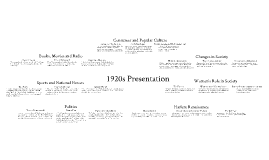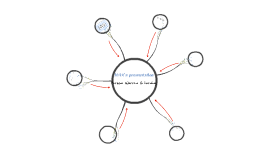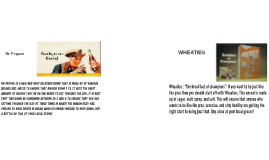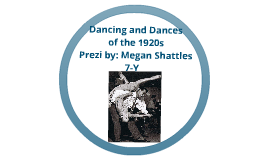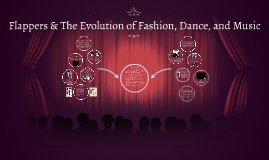1920s Presentation
Transcript: Some of the most popular dances performed by flappers were "the Tango, the Black Bottom and the biggest dance craze of all—the Charleston" (Pick, Margaret) Fashion Works Cited What is a Flapper? "A young woman, especially one who, during the 1920s, behaved and dressed in a boldly unconventional manner." As fashion was quickly evolving into a looser style, music was evolving into quicker, faster paced jazz. “jazz dances inspired young women to leave their corsets at home—and loosen up” (Pick, Margaret). Coco Chanel - French fashion designer - Trademark suits and little black dresses - Wanted comfortable clothes for women Flappers were a huge impact on the changes of the twenties. Their skirts were higher, their music was faster, and their dancing was more flamboyant. They changed the idea of what a woman should look, act, dress and dance like and they abolished any lingering traces of the cult of domesticity. “Fashion is not something that exists in dresses only. Fashion is in the sky, in the street, fashion has to do with ideas, the way we live, what is happening” (Coco Chanel). Flappers had a huge impact on the women's suffrage movement. They acted out in "unladylike" ways and launched an era of feminism. Their dancing to fast paced jazz began an evolution of music culture that was completely different from the Victorian era. In the end, they were just rebellious teens who were trying to break away from the prerequisites of their parents “Women's fashions of the 1920s are a large part of the Jazz Age identity” - Less tailoring leading to an abandonment of the corset - A tubular silhouette erased the typical feminine shape - Dropped waistlines created a long, slim figure - Shorter hemlines made it easier to drive cars and move quickly" (Monet, Dolores) “The symbols of the jazz age – its clothes, music and dancing – had to cut across social barriers” (Mackrell, Judith) Flappers were dancing to jazz music from musicians like Louis Armstrong and Duke Ellington Lasting Impact Clara Bow - Wore cloche hats - Thin eyebrows, dark eye makeup - Heart shaped lips I selected this topic because I love flappers and what they stand for. They changed the way women dress, act, and dance. The Roaring Twenties was one of my favorite decades to learn about as it was often centered around the change in feminism and how women were not trapped in the cult of domesticity anymore. Parents during the 1920s were still living in their Victorian ideologies. When they saw flappers dancing wildly to loud jazz, they were appalled. "Everyone blamed it on the music" (Pick, Margaret). The flappers coaxed the evolution of music by continuing to dance to jazz; to the horror of their elders. Flappers & The Evolution of Fashion, Dance, and Music - Boland, Jesse. “1920s Fashion: Style in The Jazz Age.” 1920s Fashion: Styles of The Roaring Twenties, 15 Apr. 2012, www.1920s-fashion-and-music.com/1920s-fashion.html. - “Flapper.” Dictionary.com, Dictionary.com, www.dictionary.com/browse/flappers. - Mackrell, Judith. “When Flappers Ruled the Earth: How Dance Helped Women's Liberation.”The Guardian, Guardian News and Media, 29 Apr. 2013, www.theguardian.com/stage/2013/apr/29/dance-womens-liberation-flappers-1920s. - Monet, Dolores. “Women's Fashions of the 1920s - Flappers and the Jazz Age.” Bellatory, Bellatory, 30 July 2017, bellatory.com/fashion-industry/WomensFashionsofthe1920-FlappersandtheJazz-Age. - Pick, Margaret Moos. “Speakeasies, Flappers & Red Hot Jazz: Music of the Prohibition.”Riverwalk Jazz - Stanford University Libraries, 2005, riverwalkjazz.stanford.edu/program/speakeasies-flappers-red-hot-jazz-music-prohibition. “This social change of the 1920s is reflected in the fashion and also gave rise to some of the most famous, fashionable and dangerous people of the decade” (Boland, Jesse) Clara Bow and Coco Chanel were some of the most famous flapper fashion icons throughout the 1920s Flappers brought about a change from the strict and modest Victorian era to a looser and more flamboyant time. The way they dressed was one of the biggest differences from the past generation






